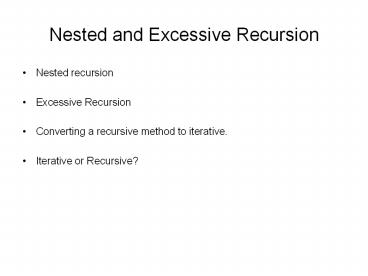Nested and Excessive Recursion - PowerPoint PPT Presentation
1 / 12
Title:
Nested and Excessive Recursion
Description:
Nested and Excessive Recursion Nested recursion Excessive Recursion Converting a recursive method to iterative. Iterative or Recursive? Nested recursion When a ... – PowerPoint PPT presentation
Number of Views:104
Avg rating:3.0/5.0
Title: Nested and Excessive Recursion
1
Nested and Excessive Recursion
- Nested recursion
- Excessive Recursion
- Converting a recursive method to iterative.
- Iterative or Recursive?
2
Nested recursion
- When a recursive method has a parameter defined
in terms of itself, it is said to be nested
recursive.
3
Nested Recursion Example
- Another example of nested recursion is Ackerman
formula - A(m,n) n 1 if m 0
- A(m,n) A(m-1, 1) if m gt 0 n 0
- A(m,n) A(m-1, A(m, n-1)) if m gt 0 n gt 0
- It is interesting for computational reasons due
to the depth of recursion and due to the nested
recursion. - The execution of Ackermann(3,2) produces
recursion of depth 30.
4
Excessive Recursion
- Some recursive methods repeats the computations
for some parameters, which results in long
computation time even for simple cases - This can be implemented in Java as follows
- int fib(int n)
- if (nlt2)
- return n
- else
- return fib(n-2)Fib(n-1)
5
Excessive Recursion Example
- To show how much this formula is inefficient, let
us try to see how Fib(6) is evaluated. - int fib(int n)
- if (nlt2)
- return n
- else
- return fib(n-2)Fib(n-1)
6
Excessive Recursion Example
- For caculating fib(6), the method is called 25
times. - The same calculation are repeated again and again
because the system forgets what have been already
calculated. - The method is called 2fib(n1)-1 times to
compute fib(n) - 3,000,000 calls are needed to caculate the 31st
element.
7
Iterative or Recursive?
- Fib can be written iteratively instead of
recursievely as follows - int iterativeFib(int n)
- if (nlt2)
- return n
- else
- int i2,tmp, current1, last 0
- for ( iltni)
- tmp current
- currentlast
- lasttmp
- return current
- The method loops (n-1) times making three
assignments per iteration and only one addition.
8
Iterative or Recursive?
Assignments Assignments Number of Additions n
Recursive Iterative Number of Additions n
25 15 5 6
177 27 9 10
1973 42 14 15
21891 57 19 20
242785 72 24 25
2692537 87 29 30
9
Excessive Recursion Example
- How many combinations of members items can be
taken from a set of group items, that is how to
calculate C(group, members)? - Base Case
- If members1, return group
- If membersgroup, return 1
- General Case
- If (groupgt membersgt1)
- return C(group-1,members-1)C(group-1,members)
10
Combination Example
11
Removing Recursion
- Some times we need to convert a recursive
algorithm into an iterative one if - The Language does not support recursion
- The recursive algorithm is expensive
- There are two general techniques for that
- Iteration
- Stacking
12
When to use Recursion
- The main two factors to consider are
- Efficiency
- Clarity
- Recursive methods are less efficient in time and
space. - Recursive methods are easier to write and to
understand - It is Good to use recursion when
- Relatively shallow
- Same amount of work as the nonrecursive verion
- Shorter and simpler than the nonrecursive solution































